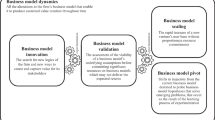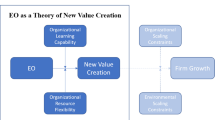Abstract
Business model innovation takes shape through a process of experimentation. This study holds that exploratory orientation is a key initiating factor of the experimentation process, and opportunity recognition and entrepreneurial bricolage both are actions constituting this process and thereby serve as conduits between exploratory orientation and business model innovation. Based on a survey data of Chinese firms, this study finds the positive relationship between exploratory orientation and business model innovation is mediated by opportunity recognition and entrepreneurial bricolage. The findings not only enrich the discipline’s knowledge on the antecedents of business model innovation but also extend the implications of exploratory orientation, opportunity recognition, and entrepreneurial bricolage to business model innovation.
Similar content being viewed by others
Notes
For a detailed literature review on business models, see Zott et al. (2011).
References
Ahlstrom, D. 2010. Innovation and growth: How business contributes to society. Academy of Management Perspectives, 24(3): 11–24.
Ahlstrom, D., & Bruton, G. D. 2010. International management: Strategy and culture in the emerging world. Mason: Cengage.
Ahlstrom, D., & Ding, Z. 2014. Entrepreneurship in China: An overview. International Small Business Journal, 32: 610–618.
Aiken, L. S., & West, S. G. 1991. Multiple regression: Testing and interpreting interactions. Newbury Park: Sage.
Amit, R., & Zott, C. 2001. Value creation in e-business. Strategic Management Journal, 22: 493–520.
Amit, R., & Zott, C. 2012. Creating value through business model innovation. Sloan Management Review, 53: 41–49.
Armstrong, J. S., & Overton, T. S. 1977. Estimating non-response bias in mail surveys. Journal of Marketing Research, 14: 396–402.
Atuahene-Gima, K. 2005. Resolving the capability-rigidity paradox in new product innovation. Journal of Marketing, 69: 61–83.
Baker, T., & Nelson, R. E. 2005. Creating something from nothing: Resource construction through entrepreneurial bricolage. Administrative Science Quarterly, 50: 329–366.
Baron, R. M., & Kenny, D. A. 1986. The moderator-mediator variable distinction in social psychological research: Conceptual, strategic and statistical considerations. Journal of Personality and Social Psychology, 51: 1173–1182.
Bauer, M., & Leker, J. 2013. Exploration and exploitation in product and process innovation in the chemical industry. R&D Management, 43: 196–212.
Brettel, M., Strese, S., & Flatten, T. 2012. Improving the performance of business models with relationship marketing efforts: An entrepreneurial perspective. European Management Journal, 30: 85–98.
Casadesus-Masanell, R., & Zhu, F. 2013. Business model innovation and competitive imitation: The case of sponsor-based business models. Strategic Management Journal, 34: 464–482.
Chesbrough, H. 2010. Business model innovation: Opportunities and barriers. Long Range Planning, 43: 354–363.
Christensen, C. M., & Raynor, M. E. 2003. The innovators solution: Creating and sustaining successful growth. Boston: Harvard Business School Press.
Demil, B., & Lecocq, X. 2010. Business model evolution: In search of dynamic consistency. Long Range Planning, 43: 227–246.
Dunbar, R. L. M., & Ahlstrom, D. 1995. Seeking the institutional balance of power: Avoiding the power of a balanced view. Academy of Management Review, 20(1): 171–192.
Eckhardt, J., & Shane, S. 2003. Opportunities and entrepreneurship. Journal of Management, 29: 333–349.
Fornell, C., & Larcker, D. F. 1981. Evaluating structural equation models with unobservable variables and measurement error. Journal of Marketing Research, 18: 39–50.
Garud, R., & Karnoe, P. 2003. Bricolage vs. breakthrough: Distributed and embedded agency in technology entrepreneurship. Research Policy, 32: 277–300.
George, G., & Bock, A. 2011. The business model in practice and its implications for entrepreneurship research. Entrepreneurship: Theory and Practice, 35: 83–111.
Giesen, E., Berman, S. J., Bell, R., & Blitz, A. 2007. Three ways to successfully innovate your business model. Strategy and Leadership, 35: 27–33.
Gupta, A. K., Smith, K. G., & Shalley, C. E. 2006. The interplay between exploration and exploitation. Academy of Management Journal, 49: 693–706.
Hamel, G. 2012. What matters now: How to win in a world of relentless change, ferocious competition, and unstoppable innovation hardcover. San Francisco: Jossey-Bass.
Hansen, D. J., Shrader, R., & Monllor, J. 2011. Defragmenting definitions of entrepreneurial opportunity. Journal of Small Business Management, 49: 283–304.
Hatcher, L. 1994. A step-by-step approach to using the SAS(R) system for factor analysis and structural equation modeling. Cary: SAS Institute.
Hayashi, A. M. 2009. Do you have a plan “B”?. Sloan Management Review, 51: 10–11.
He, Z., & Wong, P. 2004. Exploration and exploitation: An empirical test of the ambidexterity hypothesis. Organization Science, 15: 481–494.
IBM Global Business Services. 2006. Expanding the innovation horizon: The global CEO study 2006. www-07.ibm.com/sg/pdf/global_ceo_study.pdf, Accessed June 1, 2015.
Johnson, M. W., Christensen, C. M., & Kagerman, H. 2008. Reinventing your business model. Harvard Business Review, 86(12): 50–59.
Ketchen, D. J., Hult, T. G. M., & Slater, S. F. 2007. Toward greater understanding of market orientation and the resource-based view. Strategic Management Journal, 28: 961–964.
Lee, Y., Shin, J., & Park, Y. 2012. The changing pattern of SME’s innovativeness through business model globalisation. Technological Forecasting and Social Change, 79(5): 832–842.
Lévi-Strauss, C. 1967. The savage mind. Chicago: University of Chicago Press.
March, J. G. 1991. Exploration and exploitation in organizational learning. Organization Science, 2: 71–87.
McGrath, R. G. 2010. Business models: A discovery driven approach. Long Range Planning, 43: 247–261.
Nair, A., Ahlstrom, D., & Filer, L. 2007. Localized advantage in a global economy: The case of Bangalore. Thunderbird International Business Review, 49(5): 591–618.
Neter, J., William, W., & Kutner, M. H. 1985. Applied linear statistical models: Regression, analysis of variance, and experimental design. Homewood: Richard Irwin.
Nunnally, J. C. 1978. Psychometric theory, 2nd ed. New York: McGraw-Hill.
Ozgen, E., & Baron, R. 2007. Social sources of information in opportunity recognition: Effects of mentors, industry networks, and professional forums. Journal of Business Venturing, 22: 174–192.
Podsakoff, P. M., MacKenzie, S. B., Lee, J. Y., & Podsakoff, N. P. 2003. Common method biases in behavioral research: A critical review of the literature and recommended remedies. Journal of Applied Psychology, 88: 879–903.
Sambasivan, M., Abdul, M., & Yusop, Y. 2009. Impact of personal qualities and management skills of entrepreneurs on venture performance in Malaysia: Opportunity recognition skills as a mediating factor. Technovation, 29(11): 798–805.
Sarasvathy, S. D. 2008. Effectuation: Elements of entrepreneurial expertise. Cheltenham: Edward Elgar.
Sobel, M. E. 1982. Asymptotic confidence intervals for indirect effects in structural equations models. In S. Leinhart (Ed.). Sociological methodology: 290–312. San Francisco: Jossey-Bass.
Sosna, M., Trevinyo-Rodríguez, R. N., & Velamuri, S. R. 2010. Business models innovation through trial-and-error learning: The Naturhouse case. Long Range Planning, 43: 383–407.
Teece, D. J. 2010. Business models, business strategy and innovation. Long Range Planning, 43: 172–194.
Wu, W. 2008. Dimensions of social capital and firm competitiveness improvement: The mediating role of information sharing. Journal of Management Studies, 45: 122–146.
Young, M. N., Tsai, T., Wang, X., Liu, S., & Ahlstrom, D. 2014. Strategy in emerging economies and the theory of the firm. Asia Pacific Journal of Management, 31(2): 331–354.
Zott, C., & Amit, R. 2007. Business model design and the performance of entrepreneurial firms. Organization Science, 18: 181–199.
Zott, C., & Amit, R. 2008. The fit between product market strategy and business model: Implications for firm performance. Strategic Management Journal, 29: 1–26.
Zott, C., & Amit, R. 2010. Business model design: An activity system perspective. Long Range Planning, 49: 216–226.
Zott, C., Amit, R., & Massa, L. 2011. The business model: Recent developments and future research. Journal of Management, 37: 1019–1042.
Acknowledgments
This study is supported by the National Natural Science Foundation of China (71202107, 71472087, and 71472185). The authors would also like to thank Marc Ahlstrom of Rowan College at Burlington County for his editorial assistance.
Author information
Authors and Affiliations
Corresponding author
Rights and permissions
About this article
Cite this article
Guo, H., Su, Z. & Ahlstrom, D. Business model innovation: The effects of exploratory orientation, opportunity recognition, and entrepreneurial bricolage in an emerging economy. Asia Pac J Manag 33, 533–549 (2016). https://doi.org/10.1007/s10490-015-9428-x
Published:
Issue Date:
DOI: https://doi.org/10.1007/s10490-015-9428-x




